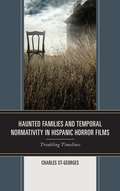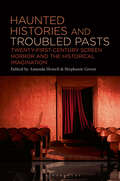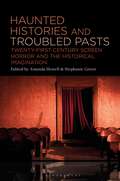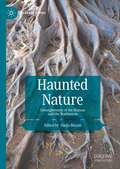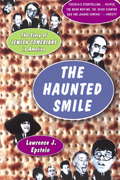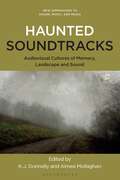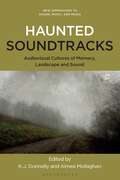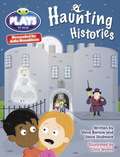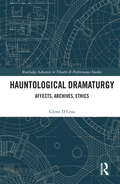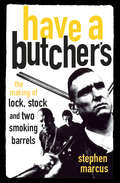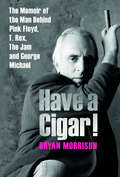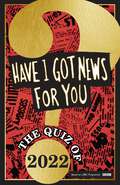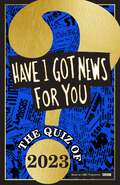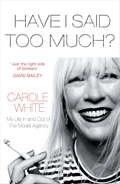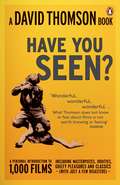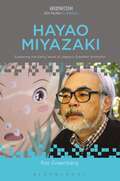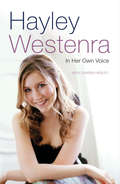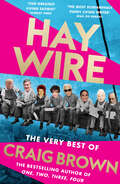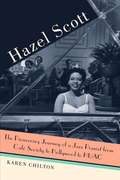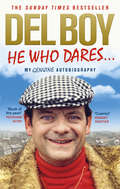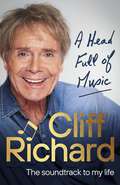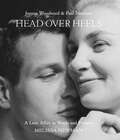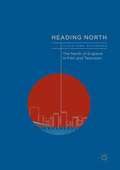- Table View
- List View
Haunted Families And Temporal Normativity In Hispanic Horror Films: Troubling Timelines (PDF)
by Charles St-GeorgesThis book examines the interactions between ghosts and families in three recent horror films from the Spanish-speaking world that, rather than explicitly referencing recent political violence, speak to the societal conditions and everyday normative violence that serve as preconditions for political violence. This study deconstructs intersectional processes of racially and sexually normative subject formation-and its oppositional other, ghostly erasure-that are framed by a common temporal logic, wherein full citizenship is contingent upon a nation's dominant notions of contemporaneousness and whether individuals properly inhabit prescriptive timelines of (re)productivity. St-Georges's study explores ways in which ghosts and families are manipulated in each national imaginary as a strategy for negotiating volatility within symbolic order: a tactic that can either naturalize or challenge normative discourses. As a literary and cinematic trope, ghosts are particularly useful vehicles for the exploration of national imaginaries and the dominant or competing cultural attitudes towards a country's history, and thus, the articulation of a present political reality. The rhetorical figure of the family is also key in this process as a mechanism for expressing national allegories, for expressing generational anxieties about a nation's relationship to time, and for organizing societies and social subjects as such, interpellating them into or excluding them from national imaginaries. By proposing these specific coordinates-ghosts and families-and by mapping their relationship between Spain and Latin America, Troubling Timelines proposes a study of a temporal framework that, besides bridging the traditional area-studies divide across the Atlantic, creates a space for interdisciplinary inquiry while also responding to increasing demand for studies that focus on intersectionality.
Haunted Histories and Troubled Pasts: Twenty-First-Century Screen Horror and the Historical Imagination
by Amanda Howell and Stephanie GreenHaunted Histories and Troubled Pasts speaks to how a transnational array of recent screen entertainments participate, through horror, in public discourses of history, the social and creative work of reshaping popular understanding of our world through the lens of the past.Contemporary film and television – and popular screen cultures more generally – are distinguished by their many and varied engagements with history, including participation in worldwide movements to reconcile past losses and injuries with present legacies. The chapters in this collection address themselves to 21st-century screen horror's participation in this widespread fascination with and concern for the historical - its recurrent reimagining of the relation between the past and present, which is part of its inheritance from the Gothic. They are concerned with the historical work of horror's spectral occupations, its visceral threats of violence and its capacity for exploring repressed social identities, as well as the ruptures and impositions of colonization and nationhood.Trauma is a key theme in this book, examined through themes of war and genocide, ghostly invasions, institutionalized abuse, apocalyptic threat and environmental destruction. These persistent, fearful reimaginings of the past can take many lurid – sometimes tritely generic – forms. Together, these chapters explore and reflect upon horror's ability to speak through them to the unspoken of history, to push the boundaries and probe the fault-lines and ideological impositions of received historical narratives – while reminding us that history and the historical imagination persist as sites of contention.
Haunted Histories and Troubled Pasts: Twenty-First-Century Screen Horror and the Historical Imagination
Haunted Histories and Troubled Pasts speaks to how a transnational array of recent screen entertainments participate, through horror, in public discourses of history, the social and creative work of reshaping popular understanding of our world through the lens of the past.Contemporary film and television – and popular screen cultures more generally – are distinguished by their many and varied engagements with history, including participation in worldwide movements to reconcile past losses and injuries with present legacies. The chapters in this collection address themselves to 21st-century screen horror's participation in this widespread fascination with and concern for the historical - its recurrent reimagining of the relation between the past and present, which is part of its inheritance from the Gothic. They are concerned with the historical work of horror's spectral occupations, its visceral threats of violence and its capacity for exploring repressed social identities, as well as the ruptures and impositions of colonization and nationhood.Trauma is a key theme in this book, examined through themes of war and genocide, ghostly invasions, institutionalized abuse, apocalyptic threat and environmental destruction. These persistent, fearful reimaginings of the past can take many lurid – sometimes tritely generic – forms. Together, these chapters explore and reflect upon horror's ability to speak through them to the unspoken of history, to push the boundaries and probe the fault-lines and ideological impositions of received historical narratives – while reminding us that history and the historical imagination persist as sites of contention.
Haunted Nature: Entanglements of the Human and the Nonhuman (Palgrave Gothic)
by Sladja BlazanThis volume is a study of human entanglements with Nature as seen through the mode of haunting. As an interruption of the present by the past, haunting can express contemporary anxieties concerning our involvement in the transformation of natural environments and their ecosystems, and our complicity in their collapse. It can also express a much-needed sense of continuity and relationality. The complexity of the question—who and what gets to be called human with respect to the nonhuman—is reflected in these collected chapters, which, in their analysis of cinematic and literary representations of sentient Nature within the traditional gothic trope of haunting, bring together history, race, postcolonialism, and feminism with ecocriticism and media studies. Given the growing demand for narratives expressing our troubled relationship with Nature, it is imperative to analyze this contested ground.
The Haunted Smile: The Story Of Jewish Comedians In America
by Lawrence J. EpsteinLawrence Epstein's The Haunted Smile tackles a subject both poignant and delightful: the story of Jewish comedians in America. For the past century and more, American comedy has drawn its strength and soul from the comic genius of Jewish performers and writers. An incomplete listing of names makes the point: The Marx Brothers, Jack Benny, Fanny Brice, George Burns, Milton Berle, Jackie Mason, Joan Rivers, Rodney Dangerfield, Mel Brooks, Alan King, Mort Sahl, Buddy Hackett, Woody Allen, Lenny Bruce, Andy Kaufman, Richard Belzer, Jerry Seinfeld. These men and women, among others, form the canon of Jewish-American comedy. In the words of the Detroit Jewish News, The Haunted Smile "offers us a deep and subtle understanding of how Jewish culture and American openness gave birth to a new style of entertainment." Often the best way to illuminate a point is to recount some of these comedians' own brilliant routines, and Epstein uses the comedian's work to great effect, making for a book that is both a thoughtful work of history and a great deal of fun.
The Haunted Smile: The Story Of Jewish Comedians In America
by Lawrence J. EpsteinLawrence Epstein's The Haunted Smile tackles a subject both poignant and delightful: the story of Jewish comedians in America. For the past century and more, American comedy has drawn its strength and soul from the comic genius of Jewish performers and writers. An incomplete listing of names makes the point: The Marx Brothers, Jack Benny, Fanny Brice, George Burns, Milton Berle, Jackie Mason, Joan Rivers, Rodney Dangerfield, Mel Brooks, Alan King, Mort Sahl, Buddy Hackett, Woody Allen, Lenny Bruce, Andy Kaufman, Richard Belzer, Jerry Seinfeld. These men and women, among others, form the canon of Jewish-American comedy. In the words of the Detroit Jewish News, The Haunted Smile "offers us a deep and subtle understanding of how Jewish culture and American openness gave birth to a new style of entertainment." Often the best way to illuminate a point is to recount some of these comedians' own brilliant routines, and Epstein uses the comedian's work to great effect, making for a book that is both a thoughtful work of history and a great deal of fun.
Haunted Soundtracks: Audiovisual Cultures of Memory, Landscape, and Sound (New Approaches to Sound, Music, and Media)
by K. J. Donnelly and Aimee MollaghanThe turn of the millennium has heralded an outgrowth of culture that demonstrates an awareness of the ephemeral nature of history and the complexity underpinning the relationship between location and the past. This has been especially apparent in the shifting relationship between landscape, memory and sound in film, television and other media. The result is growing interest in soundtracks, as part of audiovisual culture, as well as an interest in the spectral aspects of culture more generally. This collection of essays focuses on audiovisual forms that foreground landscape, sound and memory. The scope of inquiry emphasises the ghostly qualities of a certain body of soundtracks, extending beyond merely the idea of 'scary films' or 'haunted houses.' Rather, the notion of sonic haunting is tied to ideas of trauma, anxiety or nostalgia associated with spatial and temporal dislocation in contemporary society. Touchstones for the approach are the concepts of psychogeography and hauntology, pervasive and established critical strategies that are interrogated and refined in relation to the reification of the spectral within the soundtracks under consideration here.
Haunted Soundtracks: Audiovisual Cultures of Memory, Landscape, and Sound (New Approaches to Sound, Music, and Media)
The turn of the millennium has heralded an outgrowth of culture that demonstrates an awareness of the ephemeral nature of history and the complexity underpinning the relationship between location and the past. This has been especially apparent in the shifting relationship between landscape, memory and sound in film, television and other media. The result is growing interest in soundtracks, as part of audiovisual culture, as well as an interest in the spectral aspects of culture more generally. This collection of essays focuses on audiovisual forms that foreground landscape, sound and memory. The scope of inquiry emphasises the ghostly qualities of a certain body of soundtracks, extending beyond merely the idea of 'scary films' or 'haunted houses.' Rather, the notion of sonic haunting is tied to ideas of trauma, anxiety or nostalgia associated with spatial and temporal dislocation in contemporary society. Touchstones for the approach are the concepts of psychogeography and hauntology, pervasive and established critical strategies that are interrogated and refined in relation to the reification of the spectral within the soundtracks under consideration here.
Haunting Histories (PDF)
by Steve Barlow Steve SkidmoreThis title is part of Bug Club, the first whole-school reading programme that joins books with an online reading world to teach today's children to read. Grey (NC level 3A - 4C) . . . Did you hear the one about the ghosts and the school children. . . ? The children went on a school trip and the result was two hilarious haunting histories
Hauntological Dramaturgy: Affects, Archives, Ethics (Routledge Advances in Theatre & Performance Studies)
by Glenn D’CruzThis book is about some of the ways we remember the dead through performance. It examines the dramaturgical techniques and strategies that enable artists to respond to the imperative: ‘Remember Me’ – the command King Hamlet’s ghost gives to his son in Shakespeare’s famous tragedy, Hamlet. The book develops the concept of hauntological dramaturgy by engaging with a series of performances that commemorate, celebrate, investigate, and sometimes seek justice for the dead. It draws on three interrelated discourses on haunting: Derrida’s hauntology with its ethical exhortation to be with ghosts and listen to the ghosts; Abraham and Torok’s psychoanalytic account of the role spectres play in the transmission of intergenerational trauma; and, finally, Mark Fisher and Simon Reynolds’ development of Derrida’s ideas within the field of popular culture. Taken together, these writers, in different ways, suggest strategies for reading and creating performances concerned with questions of commemoration. Case studies focus on a set of known and unknown figures, including Ian Charleson, Spalding Gray and David Bowie. This study will be of great interest to students, scholars and practitioners working within theatre and performance studies as well as philosophy and cultural studies.
Hauntological Dramaturgy: Affects, Archives, Ethics (Routledge Advances in Theatre & Performance Studies)
by Glenn D’CruzThis book is about some of the ways we remember the dead through performance. It examines the dramaturgical techniques and strategies that enable artists to respond to the imperative: ‘Remember Me’ – the command King Hamlet’s ghost gives to his son in Shakespeare’s famous tragedy, Hamlet. The book develops the concept of hauntological dramaturgy by engaging with a series of performances that commemorate, celebrate, investigate, and sometimes seek justice for the dead. It draws on three interrelated discourses on haunting: Derrida’s hauntology with its ethical exhortation to be with ghosts and listen to the ghosts; Abraham and Torok’s psychoanalytic account of the role spectres play in the transmission of intergenerational trauma; and, finally, Mark Fisher and Simon Reynolds’ development of Derrida’s ideas within the field of popular culture. Taken together, these writers, in different ways, suggest strategies for reading and creating performances concerned with questions of commemoration. Case studies focus on a set of known and unknown figures, including Ian Charleson, Spalding Gray and David Bowie. This study will be of great interest to students, scholars and practitioners working within theatre and performance studies as well as philosophy and cultural studies.
Have a Butcher's: The Making of Lock, Stock and Two Smoking Barrels
by Stephen MarcusWhen Lock, Stock and Two Smoking Barrels was released in 1998, few would have prophesied quite the impact this low-budget crime comedy would have. Almost overnight it became a cultural phenomenon, launched the careers of Guy Ritchie, Matthew Vaughn and Jason Statham, amongst others, and spawned a television series and numerous British gangster film rip-offs in the process. But box office gold didn’t come without huge upheaval, and the making of the film was often fraught. In Have a Butcher’s, actor Stephen Marcus (Nick The Greek in the film) recounts the on-set dramas, the behind-the-scenes banter, his initial meeting with Guy Ritchie, the subsequent trips to Hollywood as the boys basked in success and critical acclaim, and the numerous financial problems that were only solved when Sting and Trudie Styler came on board. Drawing upon interviews with his co-stars, never-before-seen photos and original storyboards, Stephen tells the story of a film that has become a firm cult favourite.
Have A Cigar!: The Memoir of the Man Behind Pink Floyd, T. Rex, The Jam and George Michael
by Bryan MorrisonWhen the music impresario Bryan Morrison died aged 66 in 2008, after two years in a coma following a polo accident, he left behind his unpublished memoir. As a music publisher, manager and agent, Morrison had represented the Pretty Things, Pink Floyd, T. Rex, The Jam, Wham! and many others. He was the founder and owner of the Royal County of Berkshire Polo Club.In this candid and outspoken book, Morrison reveals the true stories behind why Syd Barrett of Pink Floyd once bit his finger to the bone, the Pretty Things were banned for life from New Zealand, and he became involved with the Kray Twins. He also tells how The Jam kissed goodbye to success in the USA, he received death threats when Robin Gibb left the Bee Gees, and signing a publishing deal with George Michael and Andrew Ridgeley as Wham! Spanning the golden age of British rock ’n’ roll from the 60s to the 80s, this is the extraordinary story of a cigar-chomping, East End entrepreneur, with a passion for art and design, fashion, music and polo.
Have I Got News For You: The Quiz of 2022
by Have I YouWhatever word you'd care to apply to 2022, no one can deny it's been eventful. Russia invaded Ukraine, Boris Johnson resigned, the Queen passed the baton to Charles after a 70-year reign, heat records were broken, food and energy bills went through the roof, fading celebrities discovered that libel laws are a great way to generate publicity, Liz Truss spent more money in her first week as PM than anyone since the war, and - as usual - most of the biggest stories broke while HIGNFY was off the air.What better way, then, to commemorate a year most of us probably want to forget than with over 1,000 quiz questions about it? There's the Missing Words Round, the Odd One Out Round, loads of rounds that we've nicked from other puzzle books, and for any insomniacs out there, there's even one on the Labour Party.Featuring plenty of gags and with questions on everything from politics to pop culture, Have I Got News For You: The Quiz of 2022 promises hours of entertainment (albeit probably by candlelight) and will serve as a timeless souvenir of a rollercoaster year.
Have I Got News For You: The Quiz of 2023
by Have I YouWATERSTONES' BEST BOOKS OF THE YEAR 2023: PUZZLES AND HUMOURWhether it was Harry talking about his todger in his controversial autobiography, or celebrities from Gary Lineker to Phillip Schofield and Huw Edwards dominating the news agenda, plus strikes, inflation, wildfires, the Wagner group performing the briefest mutiny of all time, an ill-fated trip to the Titanic, and - as usual - a stack of scandals leaking out of the Cabinet, 2023 has had just as many newsworthy things you'd like to forget as any other year. Before you can do that though, this book is going to quiz you on them.There's the missing words round, odd one outs, stolen formats from other quiz books, word searches, crosswords, mazes, and - as a word of warning - some close-up photographs of Michael Fabricant. With over 1,000 questions on everything from politics to pop culture, Have I Got News for You: The Quiz of 2023 promises hours of entertainment and is probably the only sardonic souvenir of 2023 going.
Have I Said Too Much?: My Life In and Out of The Model Agency
by Carole WhiteThere are model agents and there is Carole White …Every decade in Carole White’s life has been extraordinary, from her childhood in Colonial Ghana, her rebellious teenage years and own modelling career, to spending 30 years at the helm of her iconic London agency Premier.Christy, Naomi, Linda, Claudia, Cindy … White has shaped the careers of the most superlative names ever to grace a catwalk and was at the centre of the 90s supermodel storm in all its glory, drama and excess.There have been landmark court cases, size zero debates, tantrums and triumphs. And who could forget her starring role as the much-loved ‘witch’ in award-winning reality show The Model Agency?Carole’s got opinions and she’s not afraid to share them. Have I Said Too Much? is the frank and revealing story of the grande dame of modelling, as well as an exclusive insight in to this thrilling, glamorous and chaotic industry.
'Have You Seen...?': a Personal Introduction to 1,000 Films including masterpieces, oddities and guilty pleasures (with just a few disasters)
by David ThomsonThis is possibly the most entertaining, surprising and enjoyable film book ever written. Thomson set himself the near-foolhardy task of writing one page each on 1000 of the films that he has particularly liked – or in some cases, abhorred. Some half-million words of funny, vigorous, wayward prose later, we are all the happy beneficiaries of his deranged labour. Always unexpected, never repetitive, ‘Have You Seen…?’ can be read consecutively – from Abbott and Costello Meet Frankenstein to Zabriskie Point – or dipped into over many years, and it is a masterclass in how to write about films and how to love them. Sometimes Thomson will be interested in the director, sometimes in the culture that made such a film possible at such a time, sometimes in the stars (always in the stars, to be honest), and sometimes even in the outrageous cynicism and corruption of most financial backers. ‘Have You Seen…?’ is crammed with great love stories, westerns, musicals, war stories, comedies, and dramas. It is as in awe of film noir as of silent farce, and adores Hollywood but also favours British, Japanese and European cinema: camp disasters, kitsch and pretention hold no fears. If Thomson has a bottom line it is his incredulity that so much that is so enjoyable and moving and worthwhile was ever made at all – and that thanks to DVD we can now watch it forever. ‘Have You Seen…?’ will redirect how you spend your evenings for the rest of your life – for the better.
Hayao Miyazaki: Exploring the Early Work of Japan's Greatest Animator (Animation: Key Films/Filmmakers)
by Raz GreenbergHayao Miyazaki's career in animation has made him famous as not only the greatest director of animated features in Japan, the man behind classics as My Neighbour Totoro (1988) and Spirited Away (2001), but also as one of the most influential animators in the world, providing inspiration for animators in Disney, Pixar, Aardman, and many other leading studios. However, the animated features directed by Miyazaki represent only a portion of his 50-year career. Hayao Miyazaki examines his earliest projects in detail, alongside the works of both Japanese and non-Japanese animators and comics artists that Miyazaki encountered throughout his early career, demonstrating how they all contributed to the familiar elements that made Miyazaki's own films respected and admired among both the Japanese and the global audience.
Hayley Westenra: In Her Own Voice
by Darren Henley Hayley WestenraHayley's first performance as 'Little Star' in a Christmas play was perfectly pitched, beautifully sung and enthusiastically received. She was six years old. Now, at the tender age of twenty, she is the fastest-selling debut classical artist ever. Her string of musical accolades is astonishing and her audiences range from royalty to premiers.This is her story, from her first performance, through later roles in major productions such as Annie, La Bohème and The Sound of Music, her decision at the age of eleven to busk for her lunch money, and the subsequent record deals, money, charity work and classical superstardom.
Haywire: The Best Of Craig Brown
by Craig Brown‘Our greatest living satirist’ Sunday Times ‘The most screamingly funny living writer’ Mail on Sunday From the bestselling and award-winning author of Ma'am Darling and One Two Three Four, a selection of Craig Brown's finest writing collected together for the first time.
Hazel Scott: The Pioneering Journey of a Jazz Pianist, from Café Society to Hollywood to HUAC
by Karen Chilton"Hazel Scott was an important figure in the later part of the Black renaissance onward. Even in an era where there was limited mainstream recognition of Black Stars, Hazel Scott's talent stood out and she is still fondly remembered by a large segment of the community. I am pleased to see her legend honored." ---Melvin Van Peebles, filmmaker and director "This book is really, really important. It comprises a lot of history---of culture, race, gender, and America. In many ways, Hazel's story is the story of the twentieth century." ---Murray Horwitz, NPR commentator and coauthor of Ain't Misbehavin' "Karen Chilton has deftly woven three narrative threads---Adam Clayton Powell, Jr., Harlem, and Hazel Scott---into a marvelous tapestry of black life, particularly from the Depression to the Civil Rights era. Of course, Hazel Scott's magnificent career is the brightest thread, and Chilton handles it with the same finesse and brilliance as her subject brought to the piano." ---Herb Boyd, author of Baldwin's Harlem: A Biography of James Baldwin "A wonderful book about an extraordinary woman: Hazel Scott was a glamorous, gifted musician and fierce freedom fighter. Thank you Karen Chilton for reintroducing her. May she never be forgotten." ---Farah Griffin, Institute for Research in African-American Studies, Columbia University In this fascinating biography, Karen Chilton traces the brilliant arc of the gifted and audacious pianist Hazel Scott, from international stardom to ultimate obscurity. A child prodigy, born in Trinidad and raised in Harlem in the 1920s, Scott's musical talent was cultivated by her musician mother, Alma Long Scott as well as several great jazz luminaries of the period, namely, Art Tatum, Fats Waller, Billie Holiday and Lester Young. Career success was swift for the young pianist---she auditioned at the prestigious Juilliard School when she was only eight years old, hosted her own radio show, and shared the bill at Roseland Ballroom with the Count Basie Orchestra at fifteen. After several stand-out performances on Broadway, it was the opening of New York's first integrated nightclub, Café Society, that made Hazel Scott a star. Still a teenager, the "Darling of Café Society" wowed audiences with her swing renditions of classical masterpieces by Chopin, Bach, and Rachmaninoff. By the time Hollywood came calling, Scott had achieved such stature that she could successfully challenge the studios' deplorable treatment of black actors. She would later become one of the first black women to host her own television show. During the 1940s and 50s, her sexy and vivacious presence captivated fans worldwide, while her marriage to the controversial black Congressman from Harlem, Adam Clayton Powell, Jr., kept her constantly in the headlines. In a career spanning over four decades, Hazel Scott became known not only for her accomplishments on stage and screen, but for her outspoken advocacy of civil rights and her refusal to play before segregated audiences. Her relentless crusade on behalf of African Americans, women, and artists made her the target of the House Un-American Activities Committee (HUAC) during the McCarthy Era, eventually forcing her to join the black expatriate community in Paris. By age twenty-five, Hazel Scott was an international star. Before reaching thirty-five, however, she considered herself a failure. Plagued by insecurity and depression, she twice tried to take her own life. Though she was once one of the most sought-after talents in show business, Scott would return to America, after years of living abroad, to a music world that no longer valued what she had to offer. In this first biography of an important but overlooked African American pianist, singer, actor and activist, Hazel Scott's contributions are finally recognized. Karen Chilton is a New York-based writer and actor, and the coauthor of I Wish You Love, the memoir of legendary jazz vocalist Gloria Lynne.
He Who Dares
by Derek 'Del TrotterJack-the-lad, wheeler-dealer and international playboy (just ask the manageress of El Sid's, Torremolinos, 1978), this was a man destined for greatness. One day he would mature into an award-winning man of business*, thriving entrepreneur and glittering member of the jet-set. A force of nature, a man who beat the odds, if only for a bit. This is his story. The story of Derek 'Del Boy' Trotter. Who else could tell the glorious tale of rags to riches to rags to rich(ish) but the man himself? You've heard of The Wolf of Wall Street, now meet the Pug of Peckham.*Trotter's Independent Traders, employee of the year 1982 - 2003[He Who Dares has been written by the family of John Sullivan, creator and writer of Only Fools and Horses, who sadly died in 2011. Ebury Press have produced and published the book with full support and involvement of the family.]
A Head Full of Music: The soundtrack to my life
by Cliff RichardForeword by Bob StanleyOn a sunny Saturday morning in May 1956, a fifteen-year-old, then called Harry Webb, was mooching down Waltham Cross High Street. He heard some music blaring out of a parked car. It stopped him in his tracks.The song was 'Heartbreak Hotel' by Elvis Presley. It sounded like nothing he had ever heard before. In that instant, the schoolboy who was destined to take the hit parade by storm as Cliff Richard fell in love with rock and roll. It gave him the thrill, the purpose and the mission that has shaped his life ever since.Cliff lives in and for music. And with 65 years as a hitmaker, the music filling his head is a broad category. His soundtrack begins by blasting us all back into that first life-changing explosion of rock and also includes great soul soul stars such as Aretha Franklin, longtime colleagues like Elton John, and much-missed close friends Cilla Black and Olivia Newton-John.This book is meaningful to Cliff on many levels. The 30 or so songs here that make up the soundtrack to his life have each moved him deeply, but it's also about the legendary artists he met, and often got to know. He shares those stories and memories with you, too.A Head Full of Music is a vibrant personal journey for Cliff, and it's a joy to accompany him on it. Get wired for sound with him and read on.
Head Over Heels: A Love Affair in Words and Pictures
by Melissa NewmanAn invitation to the private world of Joanne Woodward and Paul Newman, one of America&’s most iconic couples, in a lavishly illustrated oversize photo book affectionately curated by their daughter Melissa Newman. Their love story is the stuff of Hollywood legend. Joanne Woodward and Paul Newman became not only movie stars and stage actors, but also artistic collaborators, political activists, and philanthropists whose legacies are expansive and enduringly modern. This visually immersive oversize book chronicles their romance through the photographs of an impressive list of contributors, including: Richard Avedon Sid Avery Ralph Crane Bruce Davidson John Engstead Leo Fuchs Milton H. Greene Philippe Halsman John R. Hamilton Leonard McCombe Gordon Parks Sanford Roth Roy Schatt Lawrence Schiller Sam Shaw Bradley Smith Stewart Stern David Sutton These striking images—many rare and some never before published—are accompanied by snapshots, letters, handwritten notes, and family treasures. Together they beautifully illuminate the connection between two complex, passionate artists who opened their hearts and minds to each other for over half a century. This book is an homage to the possibility and power of love.
Heading North: The North of England in Film and Television
by Ewa MazierskaThis collection presents a number of films and television programmes set in the North of England in an investigation of how northern identity imbricates with class, race, gender, rural and urban identities. Heading North considers famous screen images of the North, such as Coronation Street and Kes (1969), but the main purpose is to examine its lesser known facets. From Mitchell and Kenyon’s ‘Factory Gate’ films to recent horror series In the Flesh, the authors analyse how the dominant narrative of the North of England as an ‘oppressed region’ subordinated to the economically and politically powerful South of England is challenged. The book discusses the relationship between the North of England and the rest of the world and should be of interest to students of British cinema and television, as well as to those broadly interested in its history and culture.
